View the Permissions page in SharePoint
For a list or library
-
Go to the library or list and open it.
-
Select Settings  , and then Library settings or List settings.
, and then Library settings or List settings.
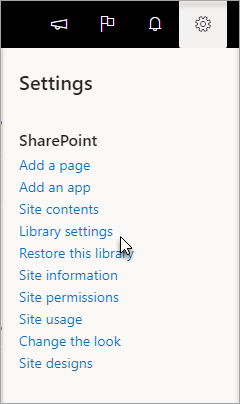
If you don't see Settings  , choose the Library or List tab to open the ribbon, and then select Library Settings or List Settings on the ribbon.
, choose the Library or List tab to open the ribbon, and then select Library Settings or List Settings on the ribbon.

-
On the Settings page, under Permissions and Management, select Permissions for this list or Permissions for this document library.
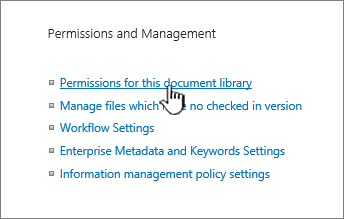
Top of Page
For a survey
-
Open the survey.
-
Select Settings.
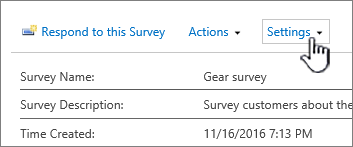
-
Select the dropdown, and select Survey Settings.
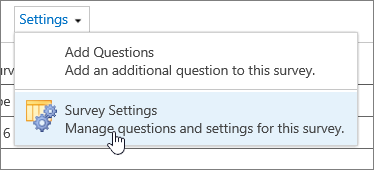
-
On the Settings page, under Permissions and Management, select Permissions for this survey.
About unique permissions for individual items
When you go to the Permissions page, you may see one or more messages at the top of the page like this:

Here's what each message means:
-
Some items of this list may have unique permissions which are not controlled from this page. Show these items. This means that, at some time in the past, an individual item within the list, library, or survey was shared with others. When you click Show these items, you will see an Exceptions dialog box showing which items they are. If you are an owner of the item, click Manage permissions for each one to make changes.
-
There are limited access users on this site. Users may have limited access if an item or document under the site has been shared with them. Show users. This means that if an item has been shared with a user, but the entire list, library, or survey has not, then their access is limited to the one item that has been shared with them. Click Show users to see who they are.
When you share an item with a user, they are given limited access to the site in order to give them access to the item. If you un-share the item, the user will continue to have limited access to the site (and you will see this message), however, they will not have access to any items not shared with them.
-
This library inherits permissions from its parent. (name of site). This means that inheritance has not yet been broken for the list, library, or survey. See Break permission inheritance below for how to do this.
Top of Page
Break permission inheritance in SharePoint
When you break permissions inheritance for a list, library, or survey and then define new permission settings, the list (or library) becomes a parent for items in it. Items under that parent now inherit the new permission settings (unless the items have uniquely defined permissions.)
To break inheritance and assign unique permissions, follow these steps:
-
Go to the list, library, or survey and open it.
-
Go to the Permissions page using the steps in the previous section.
-
To break permissions inheritance from the parent, select Stop Inheriting Permissions.

Top of Page
Assign unique permissions in SharePoint
You must break inheritance from the parent site before you can grant unique permissions. Once you've broken inheritance using the steps in the section above, follow these steps to grant unique permissions:
-
Go to the list, library, or survey and open it.
-
Go to the Permissions page using the steps in the previous section.
-
Select Grant Permissions on the Permissions tab.
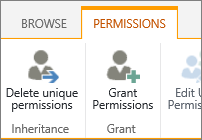
Note: If the list or library is inheriting from the parent, you won't see Grant Permissions.
-
In the Share... dialog box, make sure Invite people is selected, and then type the names of the people or group you want to grant access to in the Enter names or email addresses... box.
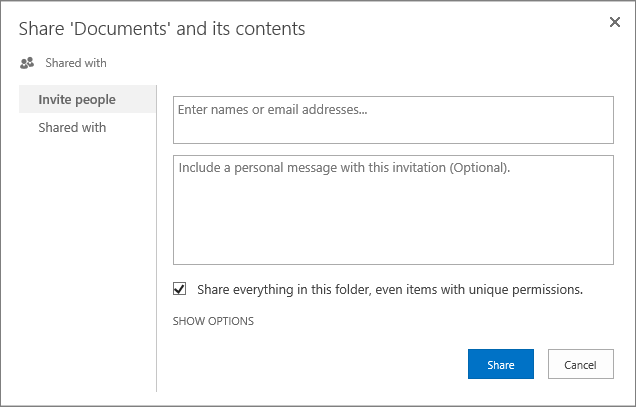
-
Add a personal message if you like.
-
Check or uncheck Share everything in this folder, even items with unique permissions. This will grant or restrict access to items you already set unique permissions for. (This option is only available for folders.)
-
The permission level granted is set to Edit by default, which means the people you invite can make some changes to the list, library, or survey. If you want to grant a different permission level like Read only, click Show options and change the selection in the Select a permission level box.
-
An email message will be sent to everyone in the Invite people box. If you don't want this to happen, click Show options, and uncheck Send an email invitation.
-
When you're done, click Share.
Top of Page
In some cases, you might want to create a Windows Active Directory security group and grant access to a library or list for all the people in the Windows security group. For example, you might want to grant your whole team access to a list by adding the team security group to a SharePoint group. Then, when new people join your team, you grant them appropriate permissions by just adding them to the appropriate Windows security group. To learn more about Windows Security groups, see Active Directory Security Groups.
Note: You cannot grant access to a distribution group that is not a Windows security group.
Change permissions levels in SharePoint
You must break inheritance from the parent site before you can change unique permissions. Once you've broken inheritance using the steps in the section above, follow these steps to change permissions:
-
Go to the list, library, or survey and open it.
-
Go to the Permissions page for the list, library, or survey using the steps in the previous section.
-
In the Name list, select the checkbox next to the name of the user or group that you change permission levels for.
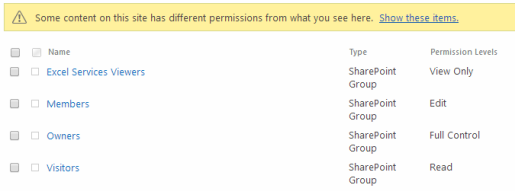
-
Select Edit User Permissions.
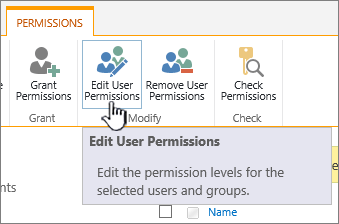
-
Under Permissions, check the box for the permission level you want for the users or groups you selected.
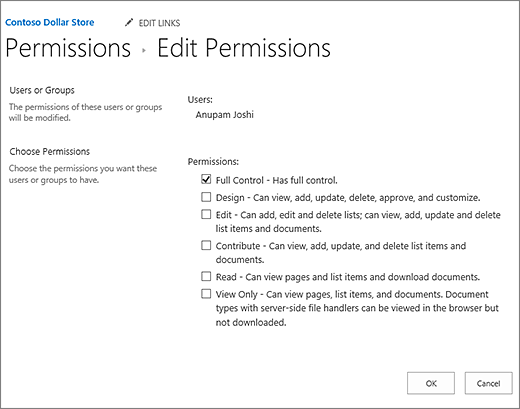
For more information about permissions levels, see Understanding permissions levels in SharePoint.
Top of Page
Remove user permissions in SharePoint
To remove permissions from users or groups that you have granted access to, follow these steps:
-
Go to the list, library, or survey and open it.
-
Go to the Permissions page for the list, library, or survey using the steps in the previous section.
-
In the Name list, select the checkbox next to the name of the user or group that you want to remove permissions from.

-
Select Remove User Permissions.
The permissions page updates to show that the group or user no longer has permissions to the list.
Restore inheritance to delete all unique permissions in SharePoint
When you break permissions inheritance between a site, folder, list, library, list item, or document and its parent, you can restore inheritance at any time, which removes any custom permissions you set.
-
Go to the list, library, or survey and open it.
-
Go to the Permissions page for the list, library, or survey using the steps in the previous section.
-
On the Permissions tab (for a list or a library), select Delete unique permissions.

-
Select OK. The status bar for the list now reports 'This list inherits permission from its parent.' The name of the parent appears next to the updated status.